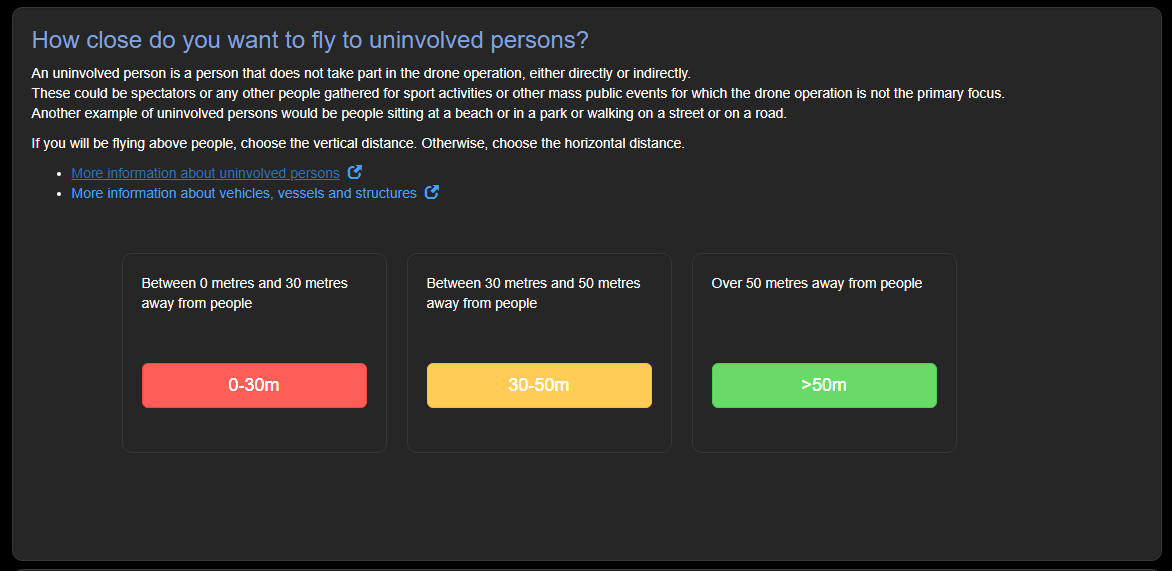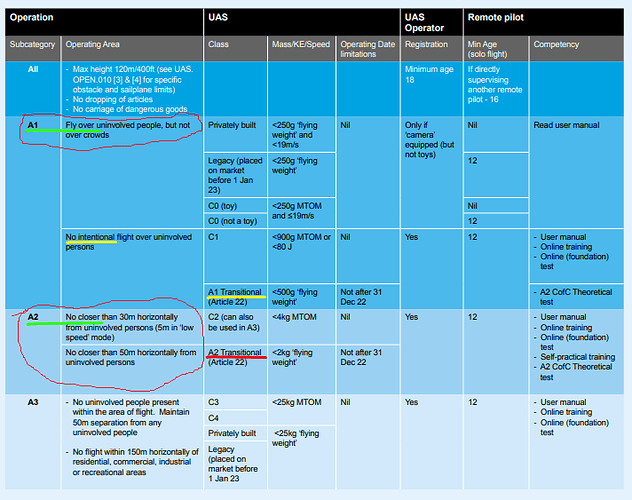But Flying close to people is Subcategory A2 not A1 (see CAP722 para 2.2.1.2 A1); A1 is flying over people and <500g drones with A2 CofC are permitted. Also, by virtue of being able to fly in Subcategory A1, permission is also granted to fly in Subcategory A2 (close to people) down to 5m (ref CAP722 App A2.2.1). Note also that the limitations for Transitional drones in CAP722 2.2.1.2 A2 refers to A2 Transitional drones, as is confirmed in the Appendices A1.3.2, and not A1 Transitional drones.
Also, why do you use distances of 0m to 30m when CAP722 uses a minimum distance 5m?
I didn’t find the screen you replied with but I did find this, which is wrong for the above reasons…
CAP2012 is your friend on all these queries, and it accurately reflects the regulations themselves, as does Good 2 Go.
This is a misunderstanding. A2 is always flying at least 50m horizontally from people. Flying closer than that in the Open category with a <500g legacy drone always takes place in subcategory A1, not A2, and Good 2 Go reflects that. The heading to CAP722 para 2.2.1.2 A1 is just a heading, and it doesn’t accurately reflect the regulations.
The key requirements for 250-499g legacy drones in the transitional period are in Article 22 of the regulations, which make clear that these can be flown in a limited version of subcategory A1 (not overhead) if an A2 CofC is held.
Good 2 Go’s results reflect that precisely.
This is also a misconception. Anything that can fly in Subcategory A1 can fly right up next to people with no minimum separation distance. The 5m is of no relevance to drones flown in A1, whether in the <250g range or the 250-499g range. Indeed, the 5m only applies to C-class drones flown in subcategory A2 in low-speed mode, and Good 2 Go does not cover those on the grounds that none currently exist.
See the footnote to CAP722 2.2.1.2 A1 which talks about A1 transitional drones. There are three types of transitional drones defined in Article 22 of the regulations: sub-500g drones flown in the limited subcategory A1 (not overhead) using an A2 CofC; sub-2kg drones flown in standard subcategory A2 using an A2 CofC; and sub-25kg drones flown in subcategory A3. The last of those is essentially irrelevant because Article 20 of the same regs allows sub-25kg legacy drones to fly in A3 indefinitely anyway. The first two of those are properly covered by Good 2 Go.
The 5m distance is, as noted above, irrelevant to legacy drones. It only applies to C-class drones that don’t yet exist. Good 2 Go uses the 0-30m distance because 30m is the boundary at which the Article 16 Operational Authorisation kicks in. At distances less than 30m, it will only ever give a “good news” answer for sub-250g drones (flying in standard subcategory A1) or for 250-499g drones accompanied by an A2 CofC (flying in the transitional variant of A1, not overhead).
I hope all that is clear, I would note that it took a lot of time to disentangle all this to build the tool!
Indeed it CAP2012 clearly does show the rules and exactly how Good 2 Go is wrong! A1 is FLYING OVER PEOPLE. A1 Transitional drone may unintentionally fly over them. They may also fly closer with nil separation (although CAP722 details this as 5m). For the accurate wording you need to read CAP722, and I’ve even detailed the references in my previous explanations that you seem to want to ignore. Here’s CAP2012 with the pertinent areas underlined (Also note that the minimum Remote Pilot age has subsequently been removed by CAA recently).
A1 subcategory is, as your extract above shows, really two different things: C0 and sub-250g drones that can be flown next to and above uninvolved people; and C1 and A1 transitional drones that can be flown next to and only unintentionally over uninvolved people.
Are you simply asking that we make it clear that for A1 Transitional drones they can also overfly if it is unintentional? Good 2 Go currently takes the approach that if the users says they do plan to fly such a drone overhead, it gives a “bad news” result.
You previously quoted CAP722 A2.2.1 as backing up the view that there is a 5m separation required for A1 transitional drones, but it says nothing about 5m separation and it’s the section for drones flying in A2. There is no 5m separation distance for drones flown in any flavour of A1. Once you establish that a drone can be flown in either flavour of A1, everything about A2 becomes irrelevant.
No need to be rude - I read them and I stated where I think you are misreading them. I’m more than happy to continue the discussion if you’re happy to be civil.
Hi Kvetner,
Firstly, I would like to apologise if I appeared rude. That was not my intention and I appreciate the effort that you have put in to this project. It is without doubt a potentially very useful tool.
What you say about the 5m distance is also true. Entitlement to flying in subcategory A1 is automtic acceptance for flying in A2 but this condition is not followed in your program.
When I tried your program, with <500g drone and A2 CofC, it first produced a screen with just two options, fly over people or not. I may fly in areas where people might walk beneath my path and this would be unintentional, so there needs to be a third option.
The next screen I encountered (shown in a previous message above) gave a red light to flying 0 to 30m, amber for 30m to 50m, and green thereafter. This is clearly wrong because based on my entry details the lights should have been green for all three scenarios as I am entitled to fly in subcategory A1.
Having said all of this, I still think your idea is extremely useful. I just think it needs tweaking.
Paul
Hi Paul, yes, I think there could be some rewording there to make things a bit clearer. There are differences in the regulations between overflying intentionally and unintentionally, and we can see if there’s scope to address this. We’re trying to avoid over-complicating it, but this is difficult given how the rules are worded.
This is an interesting comment as it suggests the user interface could mislead or confuse some users. The colours aren’t intended to suggest that each of those separation distances are ok, or not ok, they’re just colours to distinguish the buttons. Clicking on one of those three buttons will then progress towards the eventual answer, which is always “yes” or “no”. I can guess that the use of red, amber and green on some of the other pages could give the same impression and I’ll flag this with the designer to consider.
Do you have to be in a drone club to get authorisation ???
OA please explain?
Click on the “More Information” link on the relevant Good 2 Go question @Ronidog

Good to see you’re still around mate 
Huh?? But life would be so much easier if it didn’t exist … so it’s an enemy!
![]()
It would be easier if you could just go out and fly 

It would be easier if you just go out and fly 

I have had a drone licence for 18 months now but it dos not seem to count for much now, Why is it.
All they won’t is your money money money 
wil
Yes
Lol mini is it’s own exemption in it. Under 250g
Bang on mate but not over crowds assembly of people I think it actually says
I’ve got a phantom 4.
Apparently there some new stupid laws coming into place. That make flying a drone even harder, more complicated and put up unnecessary red tape.
Can someone simply explain without using a1 or sub categories terms tell me what I need in order to fly my drone Where I choose.
I don’t fly near people.
As I understand it I can fly any where unless there is a sign saying no drone in which case If I want to fly over there land I need to take off and land from out side there boundaries.
Obviously avoiding groups of people etc and sticking to common sense drone code.
Thanks
Well publicised, been here since the start of this year
Not really

